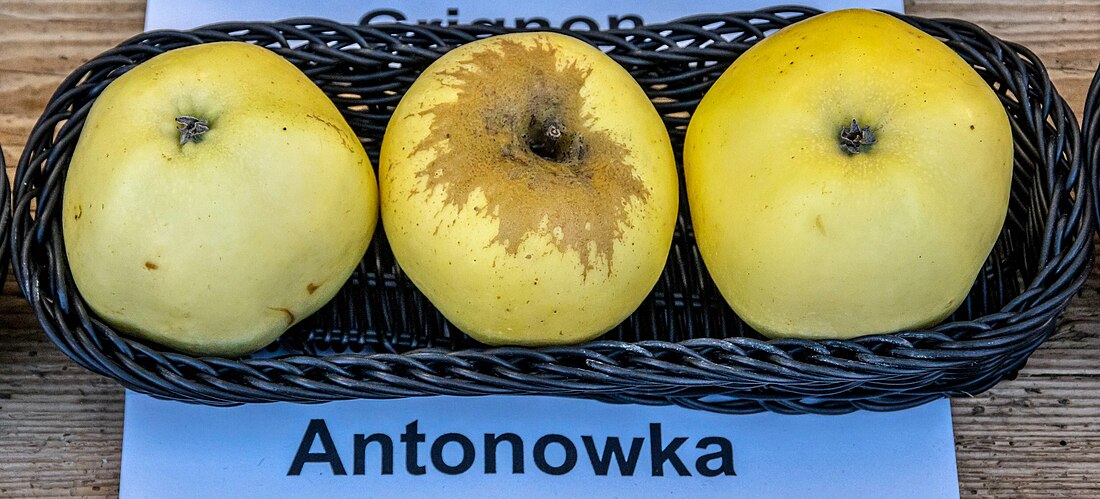Top Qs
Timeline
Chat
Perspective
Antonovka
Apple cultivar From Wikipedia, the free encyclopedia
Remove ads
Antonovka (Russian: Антоновка, Polish: Antonówka) is a group of late-fall or early-winter apple cultivars with a strong acid flavor that have been popular in Russia, including during Tsarist and Soviet times, as well as in Poland and Belarus.[2] The most popular Russian variety is the Common Antonovka (Антоновка обыкновенная), from which other cultivars are derived. Some varieties of Antonovka were bred by pioneer Russian naturalist and plant breeder Ivan V. Michurin at his experimental orchard in the Tambov Oblast and introduced in 1888.[3]
This article needs additional citations for verification. (November 2018) |
Remove ads
Cultivar of Antonovka

Antonovka is a cultivar of vernacular selection, which began to spread from the region of Kursk in Russia during the 19th century.[4] While the fruit-bearing trees have not received a wide degree of recognition outside the former Soviet Union, many nurseries do use Antonovka rootstocks, since they impart a degree of winter-hardiness to the grafted varieties.[citation needed]
Polish varieties
Poland has two varieties: Antonówka Zwykła (same, as in Russia) and Antonówka Biała also known as Śmietankowa (Antonówka White or Creamy) with considerably larger and whiter fruit ripening in late September, but also a shorter shelf life.[5]
Aia Ilu
Hardiness
The popularity of the Antonovka tree is enhanced by its ability to sustain long harsh winters, typical in many regions of Eastern Europe and Russia. It is further popular for its superior fruit preservation qualities and longevity. These qualities made the Russian variety especially popular among the dacha owners, and it remains widely grown at dachas in many post-Soviet states, where it is often called "the people's apple" (народное яблоко).[7] Extremely tolerant of cold weather, and because it produces a single, deep taproot (unusual among apple trees), Antonovka is propagated for use as a rootstock. An Antonovka rootstock provides a cold-hardy (to −45 °C), well-anchored, vigorous, standard-sized tree.
Remove ads
Uses
Due to the relatively low ratio of sugars in the fruit, Antonovka apples are especially well-suited for apple pies and late apple wine. The taste of the wine is noticeably lighter than wine from sweeter cultivars. In Poland, Antonówka is used mostly for apple preserves.

In popular culture
Ivan Bunin's early short story, "Antonov Apples" (1900), is a kind of ode to this apple cultivar as a metaphor for the departing world of the Russian landed gentry.
On August 19, 2008 a monument to the Antonovka apple was unveiled in Kursk. The sculpture was by Vyacheslav Klykov, and it has a diameter of 1.5 meters.[8]
See also
References
External links
Wikiwand - on
Seamless Wikipedia browsing. On steroids.
Remove ads

